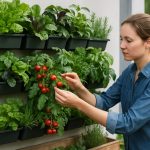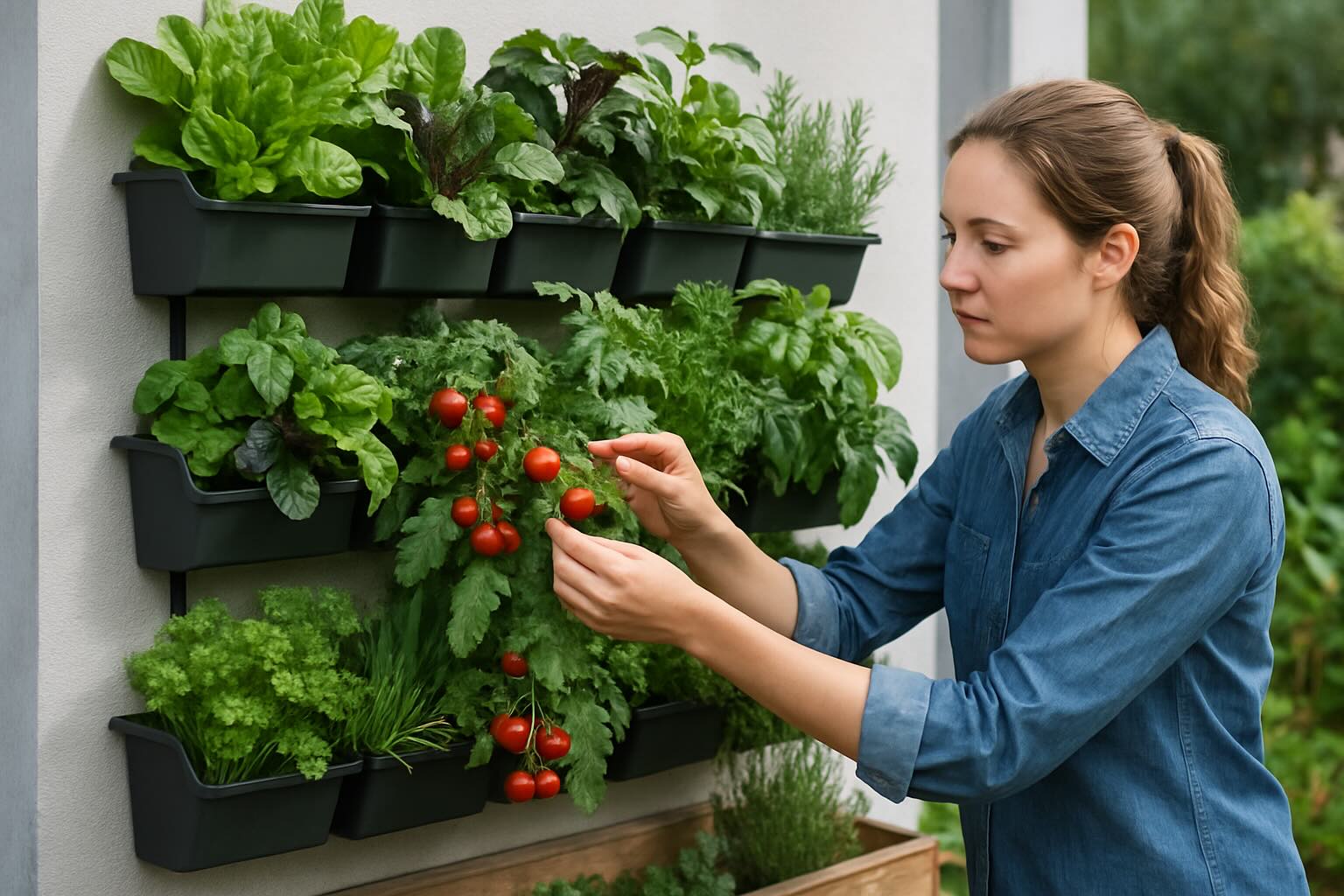What Is Vertical Gardening
Vertical gardening is exactly what it sounds like-growing plants upwards instead of spreading them out across the ground. Unlike traditional gardening, where you need a wide patch of land to plant everything in neat rows, vertical gardening flips that idea on its head. Instead of growing out, you grow up, stacking your plants skyward to make the most of the space you have.
Whether you live in a small apartment or just want to add some life to a plain fence, vertical gardening lets you grow herbs, veggies, flowers, and even fruit in tight or unused spaces. It’s a great fit for balconies, patios, rooftops, or that empty wall in your backyard that’s just sitting there.
You can use trellises, shelves, hanging pots, stackable planters, or even repurpose old pallets and shoe organizers. It’s not only practical but can also become a lovely, living decoration. With plants raised off the ground, you may also deal with fewer pests and it makes watering and picking your crops much easier.
If you’re short on space but want to grow something green, vertical gardening is a smart, flexible way to bring more plants into your life.
Vertical Gardening Methods
You don’t need a big yard or fancy gear to try vertical gardening. There are plenty of ways to set up your space, whether you’re working with a small balcony, a backyard fence, or even just a sunny wall indoors.
Here are the 7 Vertical Gardening Methods:
- Trellises and Arbors
These are classic options for climbing plants like beans, peas, and tomatoes. Build from wood, bamboo, or metal and anchor securely to the ground or a raised bed. - Hanging Baskets
These are a simple go-to for herbs, strawberries, cherry tomatoes, or flowers like nasturtiums and petunias. Use coco-lined wire baskets or plastic ones with drainage. Hang them from a pergola or railing. - Wall Planters and Vertical Racks
Wall planters include mounted pots, pocket panels, or wooden racks fixed to fences or walls. These setups are ideal for lettuces, spinach, kale, thyme, and oregano. Use lightweight containers and make sure your wall can handle the load. Anchor securely to prevent tipping in the wind. - Stacked or Tiered Planters
These work like shelves for your plants. Use tiered stands or stack containers to grow leafy veggies and flowers. They’re great for herbs, leafy greens, radishes, or pansies. Choose materials like plastic, wood, or even food-safe recycled containers. Add pebbles or holes at the bottom for drainage and rotate them occasionally so all plants get enough light. - DIY and Recycled Ideas
Want to get creative? Try turning an old ladder into a plant stand, hang mason jars on a wooden board, or use a canvas shoe organizer as a wall herb garden. Pallets can be sanded and filled with soil between the slats. Just make sure any repurposed item is clean, non-toxic, and can drain properly. - Gutter Gardens
Attach unused gutters horizontally along a fence or wall to grow shallow-rooted plants like lettuce, radishes, or mint. Drill drainage holes, add a liner if needed, and keep the soil moist but not soggy. - PVC Pipe Systems
For a more experimental setup, use vertical or horizontal PVC pipes with holes drilled into them. These work well for strawberries, herbs, and greens. Cap the ends, fill them with soil, and secure them to a wall or frame.
How to Choose the Right Structure
Think about what you want to grow. Climbing veggies need something tall and sturdy. Herbs and small greens do fine in wall pockets or stacked planters. Heavier fruiting plants like tomatoes need strong support and deeper containers. Also, check how much sun your space gets, and match your plant choices to the light conditions.
Stick to one or mix a few methods—the setup is entirely up to you. Just be sure everything’s stable, easy to water, and gets enough sunlight. With a little planning, your vertical garden will be both useful and fun to care for.
What Are the Advantages of Vertical Gardening
Vertical gardening comes with some pretty handy perks, especially if you’re tight on space or want something easy to manage.
- Saves Space
This one’s a biggie. You don’t need a huge yard to grow a lot. By growing up instead of out, you can fit more plants into smaller areas—perfect for balconies, patios, and small backyards. - Easier on Your Back and Knees
No more bending and crouching all the time. With plants raised up, it’s easier to water, trim, or harvest without the strain. Your body will thank you. - Better Airflow and Sunlight
Arranging plants vertically can help them get more even sunlight and improve airflow around them. That means healthier plants and less chance of diseases taking hold. - Fewer Weeds and Pests
Since your plants are off the ground, they’re less likely to be bothered by weeds or crawling pests. It also makes it easier to spot issues before they spread. - Make Use of Empty Walls or Fences
Got a plain wall or an ugly fence? Turn it into a living garden. It’s a creative way to bring greenery into forgotten spots. - Looks Great
Let’s be honest, vertical gardens look cool. They add life, color, and texture to any space. Whether it’s a mix of herbs or trailing flowers, it can totally change the vibe of your area. - Good for Small-Scale Growing
If you’re just growing for yourself or your family, vertical setups are often more than enough. You can grow the basics like lettuce, basil, strawberries, or even cherry tomatoes without needing a full garden plot.
Whether you’re short on room or just want to try something different, vertical gardening makes growing your own food or flowers a lot more doable.
Is Vertical Gardening Economical
It definitely can be. Vertical gardening doesn’t have to cost a lot, especially if you’re willing to get a little creative.
You can start small with things you already have at home. Think old buckets, crates, shoe organizers, or leftover wood. Pallets and ladders make great plant stands, and plastic bottles can be turned into hanging planters. With a few basic tools and a bit of time, you can set up a whole system without spending much.
Even if you buy planters or racks, the long-term savings can make up for it. Growing your own herbs, greens, and veggies means fewer trips to the store. And once you get the hang of it, you can reuse your setup season after season.
Vertical gardens also use space more efficiently, which is great if you rent or don’t have room for a big garden. And since you’ll probably deal with fewer pests and weeds, you might save money on treatments and tools.
Bottom line? You can make vertical gardening as simple or fancy as you want. Either way, it’s a budget-friendly way to grow fresh food right at home.
What Plants Grow Well in Vertical Gardening
You’ve got the setup—now what should you grow? The good news is, there’s a solid list of plants that love growing up instead of out.
Leafy Greens
Spinach, lettuce, kale, arugula, and Swiss chard do really well in vertical gardens. They don’t need deep soil and grow fast. Perfect for wall planters, stackable pots, or even hanging pockets.
Herbs
Basil, parsley, thyme, mint, oregano, cilantro—you name it. Herbs are great in small containers and don’t mind tight spaces. Just make sure they get enough sun and don’t dry out.
Strawberries
These are a vertical garden favorite. Their shallow roots make them a great fit for hanging baskets, PVC pipes, or pocket planters. Plus, they look and taste amazing.
Tomatoes
Smaller varieties like cherry or grape tomatoes are ideal. Use a sturdy trellis or cage for support and give them plenty of light. They’ll climb as they grow, and you’ll get lots of fruit in return.
Cucumbers and Peas
These climbers love to grow upward. Just give them something to grab onto like a trellis or netting. You’ll save space and keep the produce cleaner and easier to pick.
Beans
Pole beans are natural climbers and thrive in vertical setups. They grow quickly and can produce a lot in a small area.
Flowers
If you’re going for looks, go with petunias, nasturtiums, marigolds, or pansies. Many of them trail nicely and bring color to your garden wall or hanging baskets.
Stick with compact or climbing plants, give them the right support, and you’ll have a healthy, productive vertical garden in no time.
Our Vertical Gardening Experience
We started experimenting with vertical gardening a few years ago. One of us had a tiny balcony, and another had a concrete backyard. Instead of skipping the idea of growing our own food, we worked with what we had-and went vertical.
Our first project was a wooden pallet packed with herbs and leafy greens. It looked rough, and we had to replant a few times to get the light and water balance right. Still, we had fresh basil and spinach in a few weeks, and that felt like a win.
Since then, we’ve gotten creative. We’ve turned shoe organizers into herb pockets, made tiered stands out of old crates, and even mounted gutter planters along a fence. We’ve had our fair share of fails (like the time we tried to grow zucchini vertically—don’t do it), but every setup taught us something.
Our biggest takeaway? Keep it simple. Use what you have. Start small. Watch what works in your space. We’re not professional landscapers—just garden lovers figuring it out one season at a time.
Vertical gardening has helped us grow fresh food, reduce waste, and enjoy time outdoors, even in tight spaces. If you’re curious, give it a shot. You might be surprised by what you can grow with just a little sunlight and a lot of creativity.
Getting Started Is Easier Than You Think
If you’ve been thinking about growing your own food but felt limited by space, vertical gardening is a great place to start. You don’t need much—just a bit of sunlight, some containers, and a willingness to try.
Whether you’re stacking pots on a patio or hanging herbs in the kitchen, there’s a method out there that can work for you. Start with a few easy plants, keep things simple, and learn as you go.
We’ve had success and a few mess-ups along the way, but that’s part of the fun. The best part? Watching something you planted grow into something you can eat or admire.
Give it a shot. You might end up loving it as much as we do.




